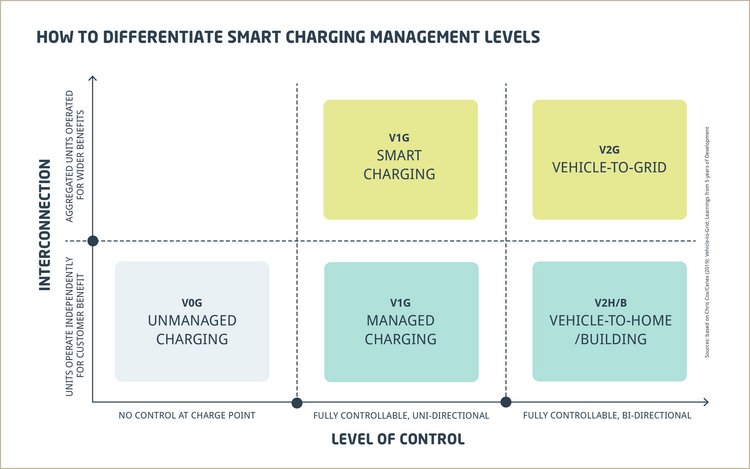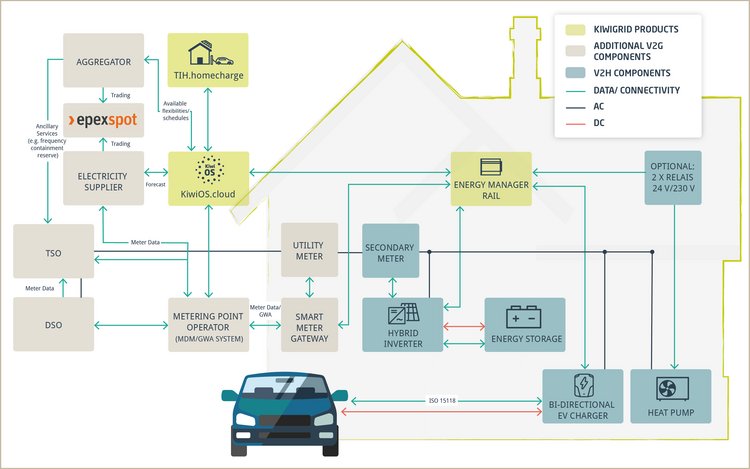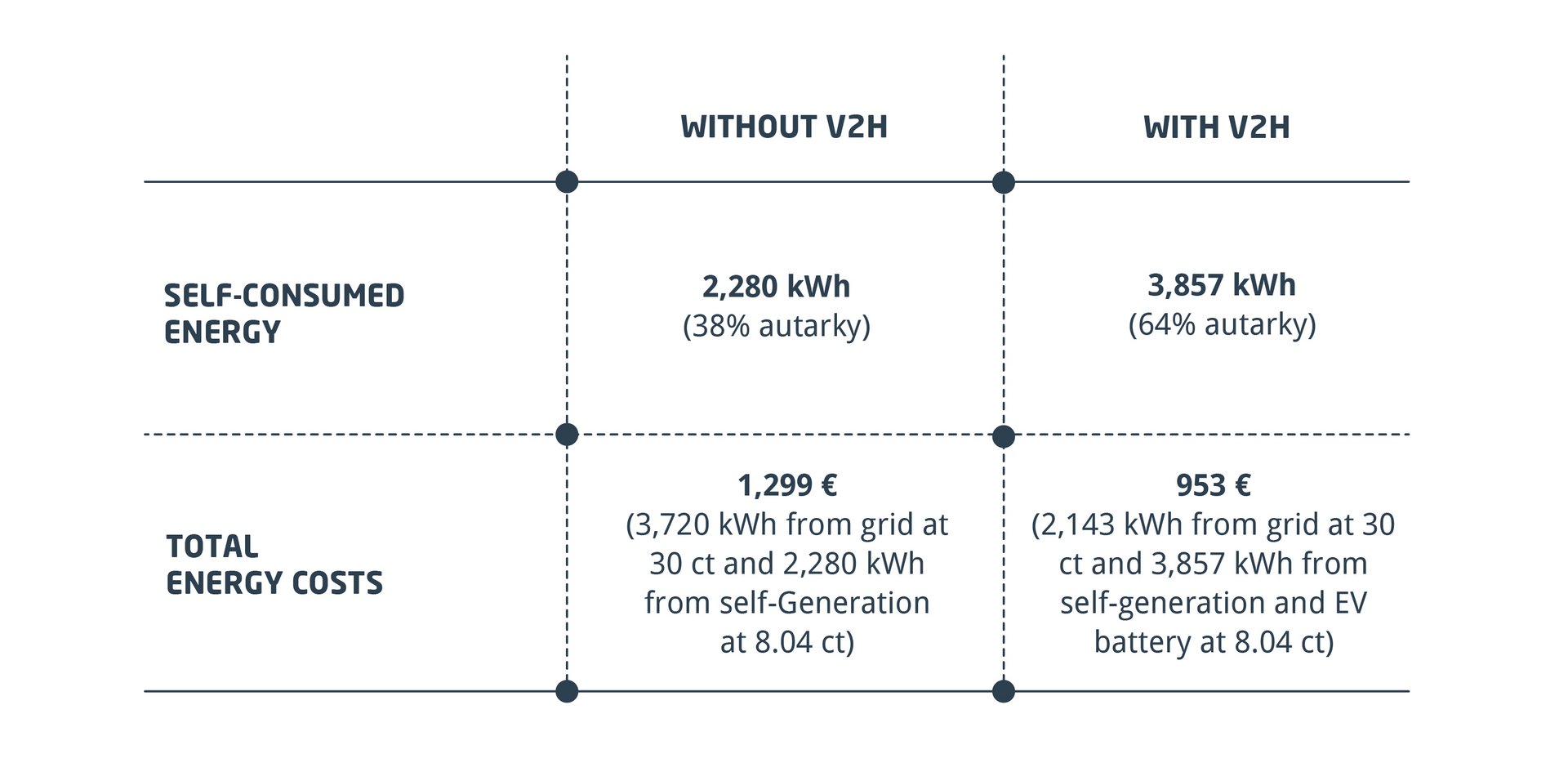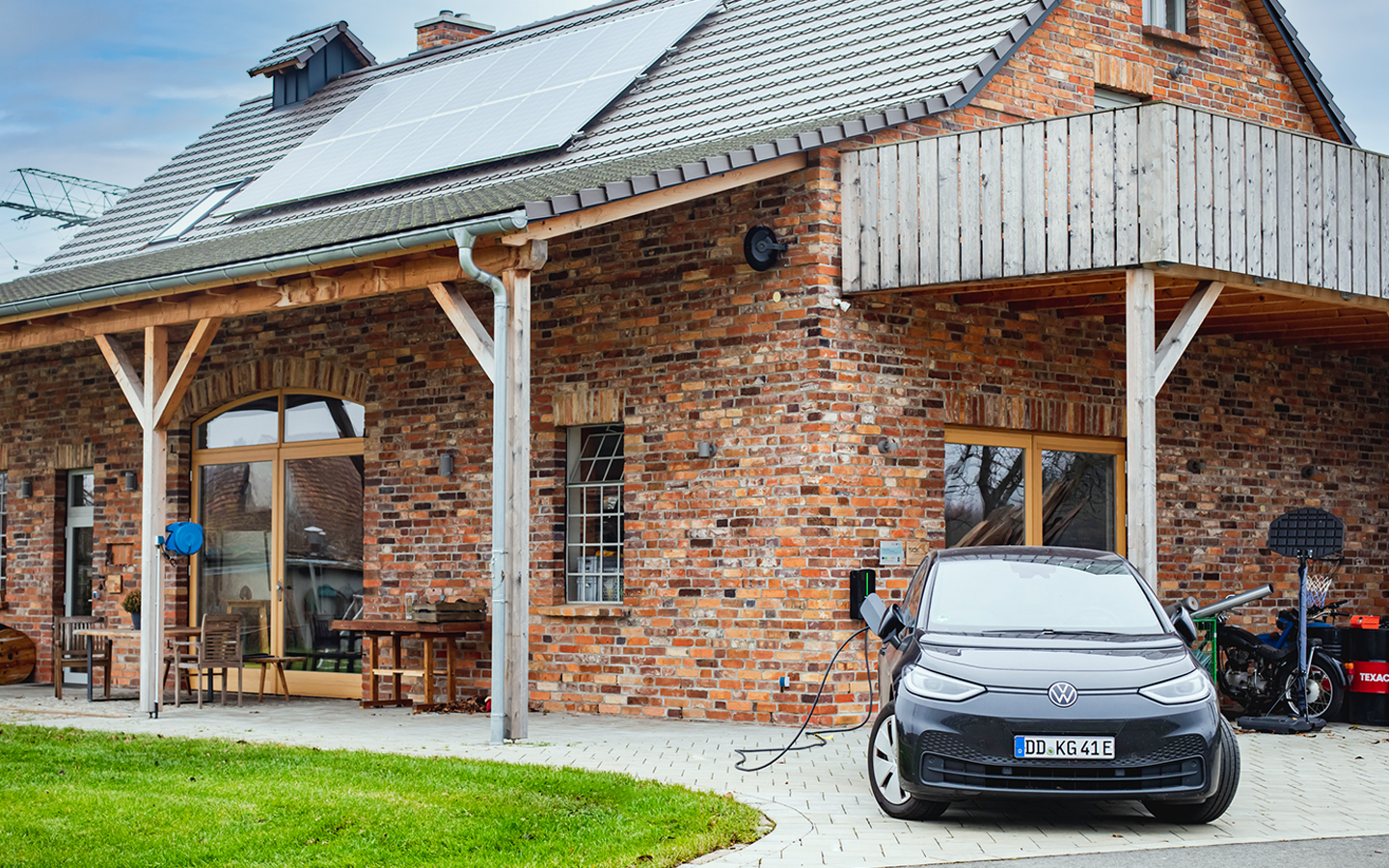What if your EV could supply your home with electricity? With a battery capacity of 77 kWh a single-family home could be supplied with electricity for a whole five days. Vehicle-to-Home (V2H) will be the most exciting use case for bidirectional charging in the coming two years – ahead of vehicle-to-grid (V2G). In this blog post, we explain why this is so and what role a home energy management system (HEMS) plays here.
What does Vehicle-to-Home mean?
In the not-too-distant future, EVs will not only be a means of transportation. As storage devices, they will also provide valuable flexibility for the power grid. We will not only charge them to drive around, but also to feed stored electricity back into the home when needed, acting just like home energy storage. This process is called V2H. SachsenEnergie AG has explained it perfectly on their blog:
„Bidirectional charging is particularly interesting for home owners. The vehicle can be used as an energy storage device: So if the e-car is just standing during the day and is connected to the electricity, the solar cells on the house roof can store surplus electricity that is not directly consumed in the car battery. If no more energy is generated at night, an entire household can easily be supplied for several hours with the car's battery charge: TV, lights, kitchen – all household consumers together are nevertheless no challenge for an average e-car battery with 40 kilowatt hours capacity and more. This type of use is called Vehicle-to-Home or V2H for short.”
V2H can also be coupled with time-of-use tariffs. To avoid high energy bills, electricity from the EV’s battery can be used during periods of high electricity prices. This not only helps end customers save on electricity costs, but also reduces the load on the grid.

Why should V2H be connected to a HEMS?
The full potential of V2H unfolds in combination with a PV system. Therefore, V2H only comes into its own when connected to a HEMS. Only then can we guarantee interoperability of the devices, freedom of device choice for end customers and the best possible energy optimization in the home.
In the vast majority of future installations, the EV home charger and PV system will come from different manufacturers, making a HEMS essential. Why? Not every manufacturer of PV inverters will bring an EV charger with bidirectional charging capacity to the market. At the same time, the most successful manufacturers of EV home chargers on the German market at the moment, including Alfen, Webasto, Mennekes, ABL, Keba, Easee and Wallbox Chargers, are unlikely to start manufacturing PV inverters.
This means we will need to connect countless combinations of devices from different manufacturers. Unlike for the communication between EV and charger, where ISO 15118 is a communication standard, there is not yet an industry standard for the communication between the PV system and charger. Therefore, not all of the possible combinations will be able to communicate with each other without the external help of a HEMS.

This example installation scheme with a PV system, DC-coupled battery storage, a bidirectional DC EV charger and an SG-ready heat pump shows how useful it is to connect the devices via an OEM-agnostic HEMS. We have included the systems required for V2G to show the different systemic complexity of V2H and V2G.
The benefits of V2H in combination with HEMS for end customers
Connecting V2H with a multi-vendor and multi-sector HEMS offers end customers and installers future-proof interoperability and freedom of choice over equipment.
Even if the majority of installers were to recommend systems by one manufacturer, this may not necessarily satisfy end customer needs. For example, emotional factors such as design and compatibility with the car brand play a much greater role for the EV charger that is visibly installed in the carport than for the PV inverter hidden in the utility room.
If the HEMS can connect not only the EV charger with the PV system, but also the heat pump and smart meter, then the HEMS knows more parameters relevant for holistic energy optimization in the house than an individual charger or inverter ever could. The HEMS realizes sector coupling of the electricity, mobility and heat sectors in the home.
What potential financial savings does V2H enable in conjunction with a HEMS?
V2H will be a success because it enables financial savings for end customers. Even without V2H, HEMS already enables significant savings by maximizing self-consumption and optimizing energy flows around the home. V2H further optimizes self-consumption of self-produced electricity, reducing residual electricity costs even more.
In this table, we have outlined the effect of V2H for a household with an annual consumption of 6,000 kWh. It shows that by using the EV’s battery, the degree of self-sufficiency almost doubles. Customers save an additional €346 per year through reduced electricity consumption from the grid.

The future potential of bidirectional charging: Vehicle-to-Grid
The benefits of bidirectional charging don’t stop at home. The EV’s battery can also be used as a flexibility for grid stabilization on the demand-side. While V2H helps to optimize the energy use of one house, V2G helps grid stabilization, including both local grid congestion management in the distribution grid and system services such as balancing energy or redispatch for the transmission grid.
V2G will play a key role in the future. In 2020, 6,100 gigawatt hours of renewable energies were lost due to feed-in management measures. With intelligent grid management, they could have been used to charge 2.5 million EVs. Instead of compensating wind and PV plant operators for curtailment measures, EV owners could earn money for the grid services provided by their cars.
In principle, V2G offers greater added value to charging infrastructure operators than V2H, but it also entails greater technical and regulatory complexity. In addition, there is still a long way to go to achieve high market penetration of V2G in Germany, as it requires a widespread deployment of smart meters. However, according to the Federal Network Agency, only 25,000 out of around eight million smart meters needed had been installed by the end of 2020.
Jan Lehmann, Teamlead Product Management at Kiwigrid, adds: “V2H alone can make a decisive contribution to grid stability. Often, many EVs and heat pumps generate a high simultaneous electricity demand. Expensive capacity must be maintained to meet this demand. V2H can reduce the simultaneous electricity demand by drawing electricity from the EV’s battery when heat pump demand is high. A dynamic tariff would increase the grid benefit even further, as EV batteries could then be charged during times of high PV and wind surplus and discharged during times of high loads and little surplus, thereby significantly reducing the load on the grid.”

What challenges does V2H still have to overcome on the way to market readiness?
The benefits of V2H for installers, end customers and the grid are clear. But the EVs, charging stations, infrastructure and communication standard needed for widespread adoption of V2H are still missing.
On the one hand, we lack affordable bidirectional EVs and EV chargers. On the other hand, the charging infrastructure sold so far is unidirectional.
Furthermore, we need a common communication standard supported by all EV and EV charger manufacturers. Such a standard is under development: “The ISO 15118 series of standards describes the framework conditions that, in addition to basic communication, enable key value-added functions for electromobility users around charging.” (NPM) Once the ISO 15118 standard is supported by the EV and the EV charger, the charge status of the EV battery can be communicated to the charger and the HEMS. Without the standard, the charge status remains unknown, meaning that the HEMS or charger do not know how much capacity the EV battery still has or how much charge is needed to cover the distances planned for the next day.
It is therefore crucial that communication be standardized and ISO-15118 implemented across all markets. Major automotive manufacturers are playing a pioneering role in the adoption of the standard. The Volkswagen Group is setting a good example with its announcement that it will support bidirectional charging based on the ISO-15118 standard.
The exciting opportunities that exist even before V2H enters the market
In our estimation, it will take another two years or so before the market penetration of bidirectional charging has progressed to the point where V2H can be widely used. But using EVs for more than just driving, and with considerable financial benefits, is already possible.
Our product The Independent Home already enables EV owners to achieve significant cost savings of up to EUR 500 per year by intelligently charging their EV at home with surplus solar power. In addition to solar-optimized charging, we have already tested the use of EVs as electricity storage and an important aspect of self-consumption optimization as part of a customer project. We want end customers to benefit from our experience in this area as soon as possible and expect to implement V2H functionalities in our product “The Independent Home” before the end of 2022. Of course, V2G is also on our roadmap.
